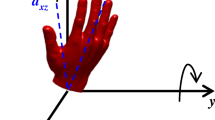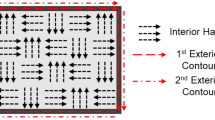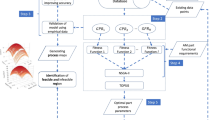Abstract
Build time is one of the crucial aspects of the fused filament fabrication (FFF) process. A reliable estimate of build time is vital, as it is the basis for estimating production cost, process planning, and build orientation optimization (BOO). In the last two decades, many researchers have developed methods to estimate the build time of FFF processes. However, the efficient applicability of these methods as low-fidelity models in lieu of high-fidelity model like G-code generation software in the context of BOO considering their correlation and computational cost has not been well researched. This paper thus initially evaluates the correlation coefficient and computational cost of different build time estimate models proposed in literature and benchmarks them with a high-fidelity model which itself is validated with experiments. Then, the work proposes a hybrid optimization framework that uses multifidelity models to obtain optimum build orientation with improved computational performance. First, we do a multi-modal build orientation optimization by a Covariance Matrix Self-Adaptation Evolution Strategy with Repelling Subpopulations (RS-CMSA) algorithm using a low-fidelity model and use these as the initial points in a gradient-based optimization method using a high-fidelity model. The proposed hybrid method has been illustrated with example case studies as well as compared and evaluated to a standard optimization algorithm using a single fidelity model to demonstrate the overall methodology and its effectiveness.

















Similar content being viewed by others
Data availability and replication of results
MATLAB® codes to replicate the results of the proposed approach for the examples discussed can be obtained from the corresponding author on reasonable request. All data generated or analyzed during this study are included in this published article (Appendix).
References
Gibson I, Rosen DW, Stucker B (2014) Additive manufacturing technologies. Springer, Springer New York, NY. https://doi.org/10.1007/978-1-4939-2113-3
Garland A, Fadel G (2015) Design and manufacturing functionally gradient material objects with an off the shelf three-dimensional printer: challenges and solutions. J Mech Des 137(11):111407. https://doi.org/10.1115/1.4031097
Kumar GS, Pandithevan P, Ambatti AR (2009) Fractal raster tool paths for layered manufacturing of porous objects. Virtual Phys Prototyp 4(2):91–104. https://doi.org/10.1080/17452750802688215
Pandithevan P, Kumar GS (2010) Finite element analysis of a personalized femoral scaffold with designed microarchitecture. Proc Inst Mech Eng [H] 224(7):877–889. https://doi.org/10.1243/09544119JEIM633
Saravana Kumar G, George SP (2017) Optimization of custom cementless stem using finite element analysis and elastic modulus distribution for reducing stress-shielding effect. Proc Inst Mech Eng [H] 231(2):149–159. https://doi.org/10.1177/0954411916686125
Bertol LS, Júnior WK, da Silva FP, Aumund-Kopp C (2010) Medical design: direct metal laser sintering of Ti-6Al-4V. Mat Des 31(8):3982–3988. https://doi.org/10.1016/j.matdes.2010.02.050
Brackett D, Ashcroft I, Hague R (2011) Topology optimization for additive manufacturing. Solid Freeform Fabrication Symposium, pp 348–362 arXiv:arXiv:1011.1669v3. https://doi.org/10.1017/CBO9781107415324.004
Thompson SM, Aspin ZS, Shamsaei N, Elwany A, Bian L (2015) Additive manufacturing of heat exchangers: a case study on a multi-layered Ti-6Al-4V oscillating heat pipe. Addit Manuf 8:163–174. https://doi.org/10.1016/j.addma.2015.09.003
Alexander P, Allen S, Dutta D (1998) Part orientation and build cost determination in layered manufacturing. Comput Aided Des 30(5):343–356. https://doi.org/10.1016/S0010-4485(97)00083-3
Costabile G, Fera M, Fruggiero F, Lambiase A, Pham D (2016) Cost models of additive manufacturing: a literature review. Int J Ind Eng Comput 8(2):263–282. https://doi.org/10.5267/j.ijiec.2016.9.001
Chan SL, Lu Y, Wang Y (2018) Data-driven cost estimation for additive manufacturing in cybermanufacturing. J Manuf Syst 46:115–126. https://doi.org/10.1016/j.jmsy.2017.12.001
Di Angelo L, Di Stefano P, Guardiani E (2020) Search for the optimal build direction in additive manufacturing technologies: a review. J Manuf Mater Process 4(3):71. https://doi.org/10.3390/jmmp4030071
Lan PT, Chou SY, Chen LL, Gemmill D (1997) Determining fabrication orientations for rapid prototyping with stereolithography apparatus. Comput Aided Des 29(1):53–62. https://doi.org/10.1016/S0010-4485(96)00049-8
Xu F, Loh HT, Wong YS (1999) Considerations and selection of optimal orientation for different rapid prototyping systems. Rapid Prototyp J 5(2):54–60. https://doi.org/10.1108/13552549910267344
Khodaygan S, Golmohammadi AH (2018) Multi-criteria optimization of the part build orientation (PBO) through a combined meta-modeling/NSGAII/TOPSIS method for additive manufacturing processes. Int J Interact Des Manuf 12:1071–1085. https://doi.org/10.1007/s12008-017-0443-7
Di Angelo L, Di Stefano P (2010) Parametric cost analysis for web-based e-commerce of layer manufactured objects. Int J Prod Res 48(7):2127–2140. https://doi.org/10.1080/00207540802183653
Yim S, Rosen D (2012) Build time and cost models for additive manufacturing process selection. Proc ASME Des Eng Tech Conf 2:375–382. https://doi.org/10.1115/DETC2012-70940
Byun H-S, Lee KH (2006) Determination of the optimal build direction for different rapid prototyping processes using multi-criterion decision making. Robot Comput-Integr Manuf 22(1):69–80. https://doi.org/10.1016/j.rcim.2005.03.001
Mungúıa J, Ciurana J, Riba C (2009) Neural-network-based model for build-time estimation in selective laser sintering. Proc Inst Mech Eng, Part B: J Eng Manuf 223(8):995–1003. https://doi.org/10.1243/09544054JEM1324
Di Angelo L, Di Stefano P (2011) A neural network-based build time estimator for layer manufactured objects. Int J Adv Manuf Technol 57(1–4):215–224. https://doi.org/10.1007/s00170-011-3284-8
Asadollahi-Yazdi E, Gardan J, Lafon P (2018) Multi-objective optimization of additive manufacturing process. IFAC-PapersOnLine 51(11):152–157. https://doi.org/10.1016/j.ifacol.2018.08.250
Di Angelo L, Di Stefano P, Guardiani E (2020) An advanced GCode analyser for predicting the build time for additive manufacturing components. Acta IMEKO 9(4):30–38. https://doi.org/10.21014/acta_imeko.v9i4.728
Di Angelo L, Di Stefano P, Guardiani E (2019) A build time estimator for additive manufacturing. 2019 IEEE International Workshop on Metrology for Industry 4.0 and IoT, MetroInd 4.0 and IoT 2019 - Proceedings, 344–349. https://doi.org/10.1109/METROI4.2019.8792907
Pandey PM, Thrimurthulu K, Reddy * NV (2004) Optimal part deposition orientation in FDM by using a multicriteria genetic algorithm. Int J Prod Res 42(19):4069–4089. https://doi.org/10.1080/00207540410001708470
Xu F, Wong YS, Loh HT, Fuh JYH, Miyazawa T (1997) Optimal orientation with variable slicing in stereolithography. Rapid Prototyp J 3(3):76–88. https://doi.org/10.1108/13552549710185644
Qin Y, Qi Q, Shi P, Scott PJ, Jiang X (2021) Automatic determination of part build orientation for laser powder bed fusion. Virtual Phys Prototyp 16(1):29–49. https://doi.org/10.1080/17452759.2020.1832793
Thrimurthulu K, Pandey PM, Reddy NV (2004) Optimum part deposition orientation in fused deposition modeling. Int J Mach Tools Manuf 44(6):585–594. https://doi.org/10.1016/j.ijmachtools.2003.12.004
Di Angelo L, Di Stefano P, Dolatnezhadsomarin A, Guardiani E, Khorram E (2020) A reliable build orientation optimization method in additive manufacturing: the application to FDM technology. Int J Adv Manuf Technol 108(1–2):263–276. https://doi.org/10.1007/s00170-020-05359-x
Padhye N, Deb K (2011) Multi-objective optimisation and multi-criteria decision making in SLS using evolutionary approaches. Rapid Prototyp J 17(6):458–478. https://doi.org/10.1108/13552541111184198
Ahrari A, Deb K, Preuss M. (2016) Multimodal optimization by covariance matrix self-adaptation evolution strategy with repelling subpopulations. Evol Comput 25(3):439-471. https://doi.org/10.1162/evco_a_00182
Möller T, Trumbore B, Moller T (1997) Fast, Minimum storage ray-triangle intersection. J Graph Tools 2(1):21–28. https://doi.org/10.1080/10867651.1997.10487468
Author information
Authors and Affiliations
Corresponding author
Ethics declarations
Ethics approval and consent to participate
Not applicable
Consent for publication
Not applicable
Conflict of interest
The authors declare no competing interests.
Additional information
Publisher's note
Springer Nature remains neutral with regard to jurisdictional claims in published maps and institutional affiliations.
Appendices
Appendix A. Calculation of support volume
Calculating the support volume is an essential step as most build-time models require the support volume information to calculate the build time. Support structures are used in FDM whenever there are overhanging features. This paper proposes a simple and efficient method using a ray-tracing algorithm for calculating the support volume, which can be used in optimization frameworks. Starting from the 3D CAD model, we identify the triangles which require support structure and project it onto the x-y plane (Fig.
17a), then these triangles are discretized into points based on the size of the triangle (Fig. 17b). The cloud of points is then rounded to integer values, and then unique points are selected (Fig. 17c). This ensures that the distance between any two points in coordinate directions will be 1 unit. These points are then used as the source for the ray-tracing algorithm (Fig. 17d). For each ray, the Möller–Trumbore algorithm [31] is applied to find the intersections with mesh triangles.
Once the support length is obtained for all the points, the support volume can be calculated by the equation below. It is assumed that each ray has a square base of ∆x =1 unit and ∆y = 1 unit dimension, and the support volume is approximated as the sum of the volume of square prisms of base area 1 unit2 and height r. To take into account the infill density, a term ID (percentage infill used for support structures) is multiplied by.
Appendix B. Optimization data
Please see Tables 3 and 4 here.
Rights and permissions
Springer Nature or its licensor (e.g. a society or other partner) holds exclusive rights to this article under a publishing agreement with the author(s) or other rightsholder(s); author self-archiving of the accepted manuscript version of this article is solely governed by the terms of such publishing agreement and applicable law.
About this article
Cite this article
Ramachandran, R., Saravana Kumar, G. Hybrid optimization for build orientation in fused filament fabrication using low- and high-fidelity build time estimation models. Int J Adv Manuf Technol 128, 4283–4301 (2023). https://doi.org/10.1007/s00170-023-11591-y
Received:
Accepted:
Published:
Issue Date:
DOI: https://doi.org/10.1007/s00170-023-11591-y





